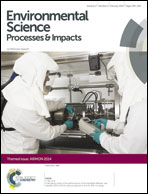Measurement of organic and elemental carbon in downtown Rome and background area: physical behavior and chemical speciation†
Abstract
A significant portion of the particulate matter is the total carbonaceous fraction (or total carbon, TC), composed of two main fractions, elemental carbon (EC) and organic carbon (OC), which shows a large variety of organic compounds, e.g. aliphatic, aromatic compounds, alcohols, acids, etc. In this paper, TC, EC and OC concentrations determined in a downtown Rome urban area are discussed considering the influence of meteorological conditions on the temporal-spatial aerosol distribution. Similar measurements were performed at ENEA Casaccia, an area outside Rome, which is considered as the ome background. Since 2000, TC, EC and OC measurements have been performed by means of an Ambient Carbon Particulate Monitor equipped with a NDIR detector. The EC and OC concentrations trends are compared with benzene and CO trends, which are specific indicators of autovehicular traffic, for identifying the primary EC and OC contributions and the secondary OC fraction origin. Further, a chemical investigation is reported for investigating how the main organic (i.e., n-alkanes, n-alkanoic acids, polyaromatic hydrocarbons and nitro-polyaromatic hydrocarbons) and inorganic (i.e., metals, ions) fractions vary their levels during the investigated period in relationship to new regulations and/or technological innovations.

- This article is part of the themed collection: AIRMON 2014

 Please wait while we load your content...
Please wait while we load your content...